View in other NatureServe Network Field Guides
NatureServe
Montana
Utah
Wyoming
Idaho
Wisconsin
British Columbia
South Carolina
Yukon
California
New York
Northern Cloudywing - Thorybes pylades
Native Species
Global Rank:
G5
State Rank:
S5
Agency Status
USFWS:
USFS:
BLM:
External Links
General Description
[From Ferris and Brown 1981; Scott 1986; Opler and Wright 1999; Glassberg 2001; Pyle 2002] Forewing 1.8-2.0 cm. Fringes brown, lightly checkered. Uppersurface dark brown and slightly lighter outward, forewing with transparent spots trianglular, small, not aligned; male with costal forewing fold. Undersurface dark brown shading outward to hoary gray, with darker hindwing median band and spikey postmedian band.
Phenology
One flight, mainly June in the north, Rocky Mountains, southern California; multiple flights southward, April through August in western Texas and New Mexico, March to December in southern Florida, March to November in northern Texas (Scott 1986). May through July in one brood areas, March to September in two brood areas (Glassberg 2001). Mid-May to July in Canada (Layberry et al. 1998). Mid-May through June in the Rocky Mountain states. Mid-May to early August in Colorado (Scott and Scott 1978; Scott and Eptein 1987), late May to late June in north-central Nebraska (Dankert and Nagel 1988), late May to late June in North Dakota (McCabe and Post 1976), early May to early July in Oregon and Washington (Pyle 2002), late April to mid-July in Oregon (Warren 2005), late April to early August in British Columbia (Threatful 1988; Guppy and Shepard 2001).
Diagnostic Characteristics
Best determined by overall dark brown color, uppersurface of forewing with transparent spots trianglular, small, not aligned; male with costal forewing fold. Undersurface shading outward from dark brown to hoary gray, with darker hindwing median band and spikey postmedian band.
Species Range
Montana Range
Range Descriptions
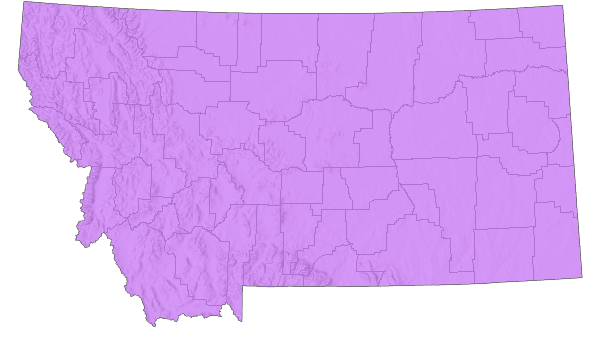
 Native
Native
Range Comments
British Columbia south through the Pacific Coast states to northern Baja California, east across southern Canada, most of western US and northern Mexico to Atlantic Coast (Scott 1986; Layberry et al. 1998; Opler and Wright 1999; Glassberg 2001); 1615 m to at least 2743 m elevation in the Rocky Mountain states (Ferris and Brown 1981), 1311 m to 3536 m elevation in Colorado (Brown 1957; Scott and Scott 1978), 15 m to at least 1524 m elevation in Oregon (Warren 2005), below 1000 m elevation in British Columbia (Threatful 1988; Guppy and Shepard 2001). In Montana, reported from at least 31 counties across the state (Kohler 1980; Stanford and Opler 1993; FLMNH Lepidopterists' Society database), 594 m to at least 1615 m elevation. Mainly common, but uncommon in California and Pacific Northwest (Glassberg 2001).
Observations in Montana Natural Heritage Program Database
Number of Observations: 6
(Click on the following maps and charts to see full sized version)
Map Help and Descriptions
Relative Density
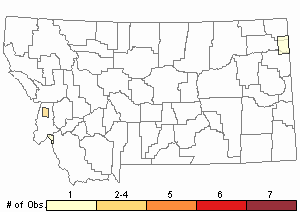
Recency
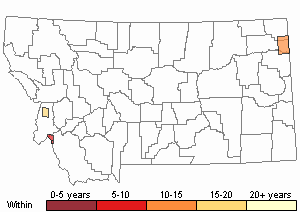
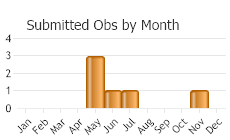
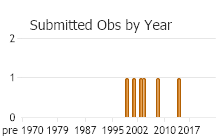
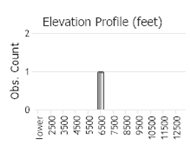 (Observations spanning multiple months or years are excluded from time charts)
(Observations spanning multiple months or years are excluded from time charts)
Migration
Non-migratory.
Habitat
Open woodlands, aspen parkland, mesic meadows, native prairie, woody riparian, canyons, roadsides (Ferris and Brown 1981; Scott 1986; Dankert and Nagel 1988; Threatful 1988; Reed 1997; Layberry et al. 1998; Opler and Wright 1999; Glassberg 2001; Guppy and Shepard 2001). Habitat in Montana not described but probably similar.
Food Habits
Larval food plants are native and exotic members of the pea family (Fabaceae), including Amorpha, Amphicarpaea, Astragalus, Desmodium (several species), Lathyrus (several species), Lespedeza (multiple species), Lotus (multiple species), Medicago, Rhynchosia, Trifolium (multiple species), Vicia, and Wisteria (Ferris and Brown 1981; Scott 1986, 1992, 2006; Layberry et al. 1998; Guppy and Shepard 2001; Graves and Shapiro 2003; James and Nunnallee 2011). Adults feed on flower nectar (including Achillea, Aesculus, Apocynum, Asclepias, Astragalus, Barbarea, Cirsium, Eriogonum, Hedysarum, Jamesia, Lathyrus, Lithospermum, Oxytropis, Pedicularis, Penstemon, Phlox, Porteranthus, Rubus, Symphoricarpos, Vicea) and mud (Dankert and Nagel 1988; Reed 1997; Tooker et al. 2002; James and Nunnallee 2011; Scott 2014).
Reproductive Characteristics
Females lay eggs singly, usually on the undersurface of host plant leaves (Scott 1986, 1992, 2006; James and Nunnallee 2011). Eggs hatch in 5-8 days (depending on temperature), develop rapidly (depending on temperature) from L1 instar to L5 instar in about 25-39 days, spend about 28-31 days as L5 instar, overwinter as full-grown L5 instar, pupate in 7-10 days (depending on temperature) in leaf shelter the following spring, adults eclose (emerge from pupae) in 12-14 days (Scott 1979; James and Nunnallee 2011). Larvae feed on host plant leaves, build silk-tied leaf tube-nests (2 leaves in early instars, 3-4 leaves in later instars), feed nocturnaly, hibernate in final nest (Scott 1986; James and Nunnallee 2011). Males perch throughout the day <1.0 m above ground among shrubs and small trees on or near hilltops (sometimes in gullies) near host plants, waiting for passing females (Scott 1975b, 1982, 1986; James and Nunnallee 2011).
Stewardship Responsibility
References
- Literature Cited AboveLegend:
 View Online Publication
View Online Publication Brown, F.M. 1957. Colorado Butterflies. Proceedings; Numbers Three through Seven. Denver Museum of Natural History, Denver, Co.
Brown, F.M. 1957. Colorado Butterflies. Proceedings; Numbers Three through Seven. Denver Museum of Natural History, Denver, Co. Dankert, N.E. and H.G. Nagel. 1988. Butterflies of the Niobrara Valley Preserve, Nebraska. Transactions of the Nebraska Academy of Sciences 16:17-30.
Dankert, N.E. and H.G. Nagel. 1988. Butterflies of the Niobrara Valley Preserve, Nebraska. Transactions of the Nebraska Academy of Sciences 16:17-30. Ferris, C.D. and F.M. Brown (eds). 1981. Butterflies of the Rocky Mountains. Univ. of Oklahoma Press. Norman. 442 pp.
Ferris, C.D. and F.M. Brown (eds). 1981. Butterflies of the Rocky Mountains. Univ. of Oklahoma Press. Norman. 442 pp. Glassberg, J. 2001. Butterflies through Binoculars: A Field Guide to the Butterflies of Western North America. Oxford University Press.
Glassberg, J. 2001. Butterflies through Binoculars: A Field Guide to the Butterflies of Western North America. Oxford University Press. Graves, S.D. and A.M. Shapiro. 2003.Exotics as host plants of the California butterfly fauna. Biological Conservation 110: 413-433.
Graves, S.D. and A.M. Shapiro. 2003.Exotics as host plants of the California butterfly fauna. Biological Conservation 110: 413-433. Guppy, C.S. and J.H. Shepard. 2001. Butterflies of British Columbia: including western Alberta, southern Yukon, the Alaska Panhandle, Washington, northern Oregon, northern Idaho, northwestern Montana. UBC Press (Vancouver, BC) and Royal British Columbia Museum (Victoria, BC). 414 pp.
Guppy, C.S. and J.H. Shepard. 2001. Butterflies of British Columbia: including western Alberta, southern Yukon, the Alaska Panhandle, Washington, northern Oregon, northern Idaho, northwestern Montana. UBC Press (Vancouver, BC) and Royal British Columbia Museum (Victoria, BC). 414 pp. James, D.G. and D. Nunnallee. 2011. Life histories of Cascadia butterflies. Corvallis, OR: Oregon State University Press. 447 p.
James, D.G. and D. Nunnallee. 2011. Life histories of Cascadia butterflies. Corvallis, OR: Oregon State University Press. 447 p. Kohler, S. 1980. Checklist of Montana Butterflies (Rhopalocera). Journal of the Lepidopterists' Society 34(1): 1-19.
Kohler, S. 1980. Checklist of Montana Butterflies (Rhopalocera). Journal of the Lepidopterists' Society 34(1): 1-19. Layberry, R.A., P.W. Hall, and J.D. LaFontaine. 1998. The Butterflies of Canada. University of Toronto Press. 280 pp. + color plates.
Layberry, R.A., P.W. Hall, and J.D. LaFontaine. 1998. The Butterflies of Canada. University of Toronto Press. 280 pp. + color plates. McCabe, T.L. and R.L. Post. 1976. North Dakota butterfly calendar (including possible strays). Journal of Research on the Lepidoptera 15:93-99.
McCabe, T.L. and R.L. Post. 1976. North Dakota butterfly calendar (including possible strays). Journal of Research on the Lepidoptera 15:93-99. Opler, P.A. and A.B. Wright. 1999. A field guide to western butterflies. Second edition. Peterson Field Guides. Houghton Mifflin Company, Boston, Massachusetts. 540 pp.
Opler, P.A. and A.B. Wright. 1999. A field guide to western butterflies. Second edition. Peterson Field Guides. Houghton Mifflin Company, Boston, Massachusetts. 540 pp. Pyle, R.M. 2002. The butterflies of Cascadia: a field guide to all the species of Washington, Oregon, and surrounding territories. Seattle Audubon Society, Seattle, Washington. 420 pp.
Pyle, R.M. 2002. The butterflies of Cascadia: a field guide to all the species of Washington, Oregon, and surrounding territories. Seattle Audubon Society, Seattle, Washington. 420 pp. Reed, C.C. 1997. Diurnal Lepidoptera of native and reconstructed prairies in eastern Minnesota. Journal of the Lepidopterists' Society 51:179-184.
Reed, C.C. 1997. Diurnal Lepidoptera of native and reconstructed prairies in eastern Minnesota. Journal of the Lepidopterists' Society 51:179-184. Scott, J.A. 1975b. Mate-locating behavior of western North American butterflies. Journal of Research on the Lepidoptera 14:1-40.
Scott, J.A. 1975b. Mate-locating behavior of western North American butterflies. Journal of Research on the Lepidoptera 14:1-40. Scott, J.A. 1979. Hibernal diapause of North American Papilionoidea and Hesperioidea. Journal of Research on the Lepidoptera 18(3): 171-200.
Scott, J.A. 1979. Hibernal diapause of North American Papilionoidea and Hesperioidea. Journal of Research on the Lepidoptera 18(3): 171-200. Scott, J.A. 1986. The butterflies of North America: a natural history and field guide. Stanford University Press, Stanford, California.
Scott, J.A. 1986. The butterflies of North America: a natural history and field guide. Stanford University Press, Stanford, California. Scott, J.A. 1992. Hostplant records for butterflies and skippers (mostly from Colorado) 1959-1992, with new life histories and notes on oviposition, immatures, and ecology. Papilio new series #6. 185 p.
Scott, J.A. 1992. Hostplant records for butterflies and skippers (mostly from Colorado) 1959-1992, with new life histories and notes on oviposition, immatures, and ecology. Papilio new series #6. 185 p. Scott, J.A. 2006. Butterfly hostplant records, 1992-2005, with a treatise on the evolution of Erynnis, and a note on new terminology for mate-locating behavior. Papilio new series #14. 74 p.
Scott, J.A. 2006. Butterfly hostplant records, 1992-2005, with a treatise on the evolution of Erynnis, and a note on new terminology for mate-locating behavior. Papilio new series #14. 74 p. Scott, J.A. 2014. Lepidoptera of North America 13. Flower visitation by Colorado butterflies (40,615 records) with a review of the literature on pollination of Colorado plants and butterfly attraction (Lepidoptera: Hersperioidea and Papilionoidea). Contributions of the C.P. Gillette Museum of Arthopod Diversity. Fort Collins, CO: Colorado State University. 190 p.
Scott, J.A. 2014. Lepidoptera of North America 13. Flower visitation by Colorado butterflies (40,615 records) with a review of the literature on pollination of Colorado plants and butterfly attraction (Lepidoptera: Hersperioidea and Papilionoidea). Contributions of the C.P. Gillette Museum of Arthopod Diversity. Fort Collins, CO: Colorado State University. 190 p. Scott, J.A. and G.R. Scott. 1978. Ecology and distribution of the butterflies of southern central Colorado. Journal of Research on the Lepidoptera 17(2): 73-128.
Scott, J.A. and G.R. Scott. 1978. Ecology and distribution of the butterflies of southern central Colorado. Journal of Research on the Lepidoptera 17(2): 73-128. Scott, J.A. and M.E. Epstein. 1987. Factors affecting phenology in a temperate insect community. American Midland Naturalist 117(1): 103-118.
Scott, J.A. and M.E. Epstein. 1987. Factors affecting phenology in a temperate insect community. American Midland Naturalist 117(1): 103-118. Stanford, R.E. and P.A. Opler. 1993. Atlas of western USA butterflies: including adjacent parts of Canada and Mexico. Unpubl. Report. Denver and Fort Collins, Colorado 275 pp.
Stanford, R.E. and P.A. Opler. 1993. Atlas of western USA butterflies: including adjacent parts of Canada and Mexico. Unpubl. Report. Denver and Fort Collins, Colorado 275 pp. Threatful, D.L. 1988. A list of the butterflies and skippers of Mount Revelstoke and Glacier National Parks, British Columbia, Canada (Lepidoptera). Journal of Research on the Lepidoptera 27(3-4): 213-221.
Threatful, D.L. 1988. A list of the butterflies and skippers of Mount Revelstoke and Glacier National Parks, British Columbia, Canada (Lepidoptera). Journal of Research on the Lepidoptera 27(3-4): 213-221. Tooker, J.F., P.F. Reagel, and L.M. Hanks. 2002. Nectar sources of day-flying lepidoptera of central Illinois. Annals of the Entomological Society of America 95(1): 84-96.
Tooker, J.F., P.F. Reagel, and L.M. Hanks. 2002. Nectar sources of day-flying lepidoptera of central Illinois. Annals of the Entomological Society of America 95(1): 84-96. Warren, A.D. 2005. Lepidoptera of North America 6: Butterflies of Oregon, their taxonomy, distribution, and biology. Contributions of the C. P. Gillette Museum of Arthropod Diversity, Colorado State University. Fort Collins, Colorado. 406 pp.
Warren, A.D. 2005. Lepidoptera of North America 6: Butterflies of Oregon, their taxonomy, distribution, and biology. Contributions of the C. P. Gillette Museum of Arthropod Diversity, Colorado State University. Fort Collins, Colorado. 406 pp.
- Additional ReferencesLegend:
 View Online Publication
View Online Publication
Do you know of a citation we're missing? Allen, T.J., J.P. Brock, and J. Glassberg. 2005. Caterpillars in the field and garden: a field guide to the butterfly caterpillars of North America. Oxford University Press.
Allen, T.J., J.P. Brock, and J. Glassberg. 2005. Caterpillars in the field and garden: a field guide to the butterfly caterpillars of North America. Oxford University Press. Brock, J.P. and K. Kaufman. 2003. Kaufman Field Guide to Butterflies of North America. Houghton Mifflin Company, New York, NY 284 pp.
Brock, J.P. and K. Kaufman. 2003. Kaufman Field Guide to Butterflies of North America. Houghton Mifflin Company, New York, NY 284 pp. Forister, M.L., C.A. Halsch, C.C. Nice, J.A. Fordyce, T.E. Dilts, J.C. Oliver, K.L. Prudic, A.M. Shapiro, J.K. Wilson, J. Glassberg. 2021. Fewer butterflies seen by community scientists across the warming and drying landscapes of the American West. Science 371:1042-1045.
Forister, M.L., C.A. Halsch, C.C. Nice, J.A. Fordyce, T.E. Dilts, J.C. Oliver, K.L. Prudic, A.M. Shapiro, J.K. Wilson, J. Glassberg. 2021. Fewer butterflies seen by community scientists across the warming and drying landscapes of the American West. Science 371:1042-1045. Forister, M.L., E.M. Grames, C.A. Halsch, K.J. Burls, C.F. Carroll, K.L. Bell, J.P. Jahner, et al. 2023. Assessing risk for butterflies in the context of climate change, demographic uncertainty, and heterogeneous data sources. Ecological Monographs 93(3):e1584. https://doi.org/10.1002/ecm.1584
Forister, M.L., E.M. Grames, C.A. Halsch, K.J. Burls, C.F. Carroll, K.L. Bell, J.P. Jahner, et al. 2023. Assessing risk for butterflies in the context of climate change, demographic uncertainty, and heterogeneous data sources. Ecological Monographs 93(3):e1584. https://doi.org/10.1002/ecm.1584 Fultz, J.E. 2005. Effects of shelterwood management on flower-visiting insects and their floral resources. M.Sc. Thesis. Bozeman, MT: Montana State University. 163 p.
Fultz, J.E. 2005. Effects of shelterwood management on flower-visiting insects and their floral resources. M.Sc. Thesis. Bozeman, MT: Montana State University. 163 p.
- Web Search Engines for Articles on "Northern Cloudywing"
- Additional Sources of Information Related to "Insects"





